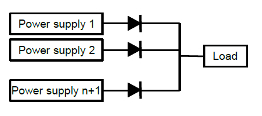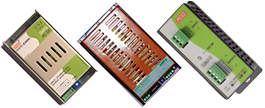
FAQ
What is SMPS?
It is Switched Mode Power Supply.
What is difference between SMPS & Linear Power Supply.
Linear Power Supply is Transformer based Regulated Power Supply which is big in size or Bulky, heavy in weight and operates at 50/60 Hz. SMPS is high frequency ( In Khz) based regulated power supply which is small in size and light in weight.
Which is best: switching mode or linear?
It depends on what you mean by "best". You may get some guidance from the following table:
| Type | Strength | Weakness |
|---|---|---|
| Linear |
|
|
| SMPS |
|
|
How to choose SMPS?
It is depends on your requirement of Voltage and Current or Wattage. It may be single/Dual/Triple/ Multi Output and Current of every output required.
How to choose the rating of SMPS?
It is Thumb Rule to choose SMPS rating 25-30 % more than required to have increased reliability. e.g If you require 24 dc @ 7.5 A choose Model which will give 24 v dc @ 10 A. By doing so reliability and life of SMPS is increased.
Do I get all the outputs Regulated?
No. Main output will be regulated and other Auxiliary output will be Unregulated.
What is the regulation SMPS gives?
For Main output +/- 2-3 % And for Auxiliary winding/ Output +/- 10%
What is about UV/OV protection?
All the SMPS are Input Under voltage & Over Voltage protected as well as Temp protected.
What are the Protections at output?
All SMPS are Overload and Short circuit proof. No damage will cause to SMPS.
What is Load and Line Regulation ?
Load regulation is how much the output voltage changes when the load changes, usually from
0 to 100% of rating. Typical specifications are from 1% to 0.1%
Line regulation is how much the output changes for a change in the input AC voltage. It is usually specified as mV per a given change of the input or as a percentage change over the whole allowed input range.
What Ripple & Noise ? How it is measured?
Ripple can be defined as the portion of unfiltered AC voltage and noise present at the output of a filtered power supply when operated at full load and is typically specified in volts RMS. Noise on the other hand is is typically specified as peak-to-peak AC voltage and can be defined as the
portion of unfiltered and unshielded EMI noise present at the output of a filtered power supply when operated at full load.
The easiest measurement is to connect an AC-coupled oscilloscope to the output of the power supply. The measurement can be made of common-mode noise (noise on both + and - outputs of the power supply with respect to the AC power ground) or normal-mode (also called differential-mode) noise, which is the noise seen between the + and - terminals of the power supply.
How do measure Power Supply efficiency?
The measured efficiency in percent is given as Pout / Pin x 100 where P in is the measured AC power in W ( V in X I in X Pf ) and Pout is the measured DC power out in W( V out dc x I out dc )
What is in rush current ?
At input side, there will be (1/2 ~1 cycle, ex. 10-20 mS for 50 Hz AC source) large pulse of current of 20~60A based on the design of SMPS at the moment of power on and then back to normal rating. This "Inrush Current" will appear every time you turn on the power. Although it will not damage the power supply.
What is PFC?
It is Power Factor Correction at Input side. For Non PFC model it is 0.4 -0.65 and for PFC
models it will be near to 0.95.
The calculation formula is as below:
- Apparent Power=Input Voltage x Input Current (VA)
- Real Power= Input Voltage x Input Current x Power Factor (W)
- so Power Factor= Real Power/ Apparent Power = W/VA
What is Delivery Period?
For Standard Automation Series, Security Series and Qty upto 10 Nos are in stock. Other Specialised/Custom Built SMPS are made as per the Order. And Delivery Period varies from 1-6 weeks depends upon Qty and Complexity
What is about after sales service?
Normally PESS Make SMPS does not require service, As we maintain best Quality of Products. Even if service is required , we provide service for repairs. You have to send the SMPS to our factory.
What is maximum delivery period for Repairs?
It is 10 days Max.
What is MTBF ? Isit different from life cycle?
MTBF and Life Cycle are both indicators of reliability. An expected reliability is forecasted through accounting component's number (exclude fans). The exact meaning of MTBF is after continuously using of power supply in a certain time, the probability of operating properly is 36.8%(e-1=0.368). If power supply is continuously used at double the MTBF time, the probability of operating properly becomes 13.5%(e-2=0.135).
Life Cycle is found through using the temperature rise of electrolytic capacitor to estimate the approximate life of power supply. For example, SP-750-12 MTBF=769.3K hours; electrolytic capacitor C108 Life Cycle=202.2K hours (Ta=45oC).
Cooling fans have a relatively shorter lifetime (typical MTTF, Mean Time To Failure, of around 5000-10000 hours) as compared with other components of power supplies.
Why and when fan is required in SMPS ?
Models above 100 W requires forced cooling so fan is required. Control of fan depends on either Temp of heat sink or continuous.
Do I use SMPS for Battery Charging.
No. You can not use SMPS for charging battery directly. It will damage the Battery. To charge battery separate range of SMPS is there called ‘SMPS based Battery chargers’
Do I connect the SMPS is series to increase voltage?
Yes, But if model suits. That means SMPS should have internal ORing Diode. There is limitation. Better contact factory.
Do I connect SMPS in Parallel to increase Current capacity.
Yes, If model suits. That means SMPS should have internal ORing Diode. If it does not have internal, then externally it must be connected before put in parallel. Else you will damage the SMPS.

WHAT is EMI & RFI ?
EMS is Electro Magnetic Interference and RFI is Radio Frequency Interference. These are caused by switching of the Power Supply.
What Y Capacitor:
Due to the requirement of EMI, there will be some Y capacitors between line and neutral to the FG (case) to improve EMC. These Y capacitors will cause some leakage current flow from line or neutral to the case (normally case will be connected to earth ground). For example, IEC-60950-1 requires that this current should be less than 3.5mA for IT equipment, so basically the leakage current you find on the case will not hurt human body. Proper connection to Earth ground will solve the leakage current problemThe Y capacitor is used to reduce EMI
What X Capacitor?
X capacitor is Put Across Line and Neutral of Input of SMPS. It is used to reduce EMI & RFI as well as to reduce the surges coming on input.
-

Telephone
91-20-2448 3234, 2448 7774
-

Mobile
0-9764953045 , 0-9822970350
